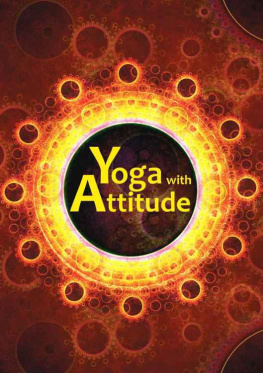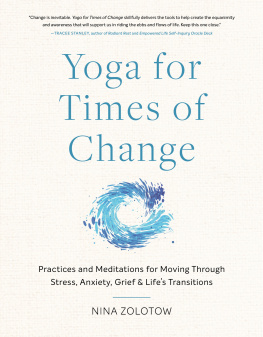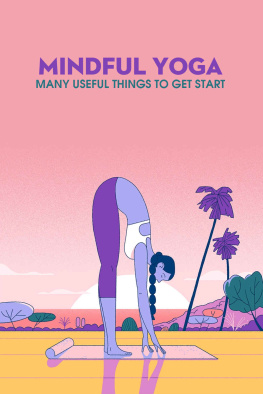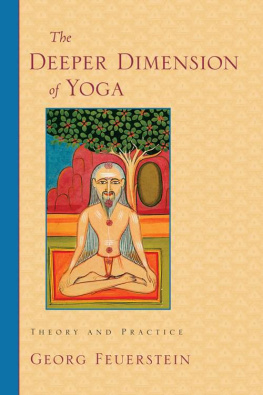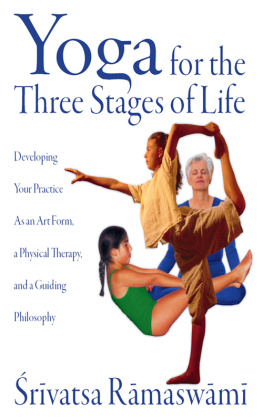
Yoga with Attitude revised 2nd edition 2013 Yoga Association of Victoria. All rights for use and reproduction in whole or part, in any media, of this book are reserved. Use of this material in a course requires permission.
This book was initially designed as a companion to the Living Consciously courses at SATYANANDA YOGA Rocklyn in Victoria, Australia. For information on these courses contact: www.yogavic.org.au.
SATYANANDA YOGA is a registered trademark of IYFM. Living Consciously is a registered trademark of the Yoga Association of Victoria.
Published by The Yoga Association of Victoria. This book is available from The Yoga Association of Victoria and many other Satyananda Yoga book sellers.
Print copies are also available. Visit www.yogavic.org.au for details.
National Library of Australia Cataloguing-in-Publication entry : (ebook)
Title: Yoga with attitude : a practical handbook for developing awareness in everyday living / compiled by Vimalratna Saraswati.
Edition: 2nd edition.
ISBN: 9780987519412 (ebook)
Notes: From the teachings of Satyananda Saraswati and the teachings of Niranjanananda Saraswati.
Includes bibliographical references and index.
Subjects:Saraswati, Satyananda Swami 1923-2009--Teachings.
Saraswati, Niranjanananda Swami 1960---Teachings.
Yoga.
Meditation.
Self-actualization (Psychology)
Self psychology.
Other Authors/Contributors:
Saraswati, Vimalratna, compiler.
Dewey Number: 181.45
Yoga with Attitude
A practical handbook for developing awareness in everyday living.
From the teachings of Swami Satyananda & Swami Niranjanananda.
_______________________________________
The origins of these teachings are drawn directly from the teachings of Swami Satyananda & Swami Niranjanananda. Their inspiration led us to present their ideas in this particular style so as to be more easily understood and assimiliated by the reader.
_______________________________________
Compiled by Swami Vimalratna

Contents
Introduction
There is much more to yoga
Most people are familiar with the idea that yoga involves physical postures. Many people have undertaken a weekly class at their gym or with a yoga teacher in their community. Others have heard of yoga in relation to breathing practices, relaxation, and meditation. Yoga does involve these things and they are fundamental to the way yoga works.
Yet this isnt all there is. There is much more to yoga. It is a complete system for managing our situation in life. It provides a comprehensive set of tools for managing change and for living to our full potential. When yoga overflows out of the weekly class and into our lives it starts to become part of a process of personal transformation. When yoga practices become part of our daily routine, something begins to shift in our bodies, our minds, emotions and energy.
There is another aspect of yoga that complements the physical practices. When we open ourselves to change with the physical yoga practices, life may reveal itself in ways we hadnt previously considered. We are often confronted by the deeper unresolved parts of ourselves. We also discover opportunities for a richer fuller life.
There are many books that describe the physical yoga practices and a few books that describe ways to integrate them into a lifestyle. Books that can be recommended include Asana Pranayama Mudra Bandha by Swami Satyananda Saraswati and Introduction to Asana and Pranayama published by the Yoga Association of Victoria.
In Yoga with Attitude, the physical practices are implicitly valued and recommended, and is designed as a companion to them. The focus here is on developing parallel skills and they will be greatly enhanced if integrated with other practices such as yoga postures, breathing techniques, and meditation.
A primary aim of this book is to use the details of everyday living as raw material for developing and maintaining self-awareness. This has always been part of the yoga tradition, but it is sometimes overlooked in yogas recent popular forms. This book focuses on techniques for developing self-observation, which in turn assists us to reflect more impartially and act more wisely. It also includes methods to focus on attitudes. These key qualities harmonise our actions and assist us uncover a quieter mind. Although some of the content may be seen as ethical or moral, the benefits are directly linked with common sense, clear focus in life, and the joys of an untroubled mind.
This systematic progression to a quiet mind is traditionally known as the process of developing pratyahara withdrawal of the mind from the senses where the layers of physical, sensual, emotional and mental awareness are traversed, explored and released on the way to creating a quiet mind capable of the deeper states of meditation. Even if we were to go no further, the practical benefits of a quiet mind are of great value.
The concepts and practices in this book are designed to become a companion through each day, giving a focus to hold through the details of life, whatever life entails. The themes systematically build one on the other. You may browse your way, picking and choosing ideas that appeal, however, the most effective process will be to begin at the first task and proceed step by step from there. Each specific task within a topic is highlighted with the symbol:
***
You will find it helpful to allocate a set amount of time to each task. Take a minimum of at least a day. A week on each task, or a month, will generally be productive. You may wish to repeat a chapter before you move on to the following sections. Allow plenty of time for the ideas to be grounded in experience and for the meaning and effects to be investigated and absorbed.
At first it may be difficult to hold the topic in the mind as you engage with the normal activities. Indeed this is the greatest challenge. Written reminders help. Associating the task with a specific part of the day or a specific activity such as eating, for example, or even putting on your shoes, will also reinforce the idea.
One way to maintain focus on the tasks given in the book is to take ten minutes at the end of every day and reflect, mentally, or in writing, on any thoughts that emerge in relation to the task and the events of the day.
With practice these tasks and themes come to rest in the background throughout the day, emerging in every relevant situation.
This book was conceived as a potential companion to courses being developed at the SATYANANDA YOGA Ashram in Rocklyn, Victoria, Australia. The courses explore aspects of yoga that relate to awareness and attitude. Participants in the original courses are involved each day in practical activities and yoga practices while reflecting on progressively developed daily themes.
The origins of these practices are drawn directly from the teachings of Swami Satyananda, Swami Niranjanananda and Swami Sivananda. Their inspiration led us to present their ideas in this particular style so as to be more easily understood and assimilated by the reader.
This second edition of the book more directly aligns the practices with the source quotes from these teachers and contains a substantially revised and expanded second part.
Part One:
Yoga with Awareness
Chapter 1
Developing the capacity
for self-observation
There are some days, perhaps only moments, when the mind is clear and open, when the body moves without effort, when the emotions feel light, weightless, and nothing worries us at all. There is a feeling of enjoyment with whatever is happening, a feeling of floating through life.
Next page
